What Money Canã¢â‚¬â„¢t Buy Family Income and Childrenã¢â‚¬â„¢s Life Chances
This entry presents the evidence on global economic inequality. It considers economic history and how global inequality has inverse and is predicted to go on changing in the future.
A related entry on Our Globe in Data presents the empirical evidence of how income inequality has inverse over time, and how the levels of inequality in different countries tin can vary significantly. It also presents some of the research on the factors driving the inequality of incomes.
All our charts on Global Economic Inequality
Global inequality of opportunity
Living atmospheric condition are vastly unequal between dissimilar places in our world today. This is largely the consequence of the changes in the terminal two centuries: in some places living atmospheric condition changed dramatically, in others more slowly.
Our individual stories play out amidst these major global changes and inequalities and it is these circumstances that largely decide how good for you, wealthy, and educated each of us will be in our own lives.ane Aye, our ain hard work and life choices matter. But equally nosotros will meet in the information, these matter much less than the one big thing over which we have no control: where and when we are built-in.This single, utterly random, factor largely determines the conditions in which nosotros live our lives.
Today's global inequality is the consequence of ii centuries of unequal progress. Some places have seen dramatic improvements, while others have not. It is on us today to fifty-fifty the odds and give everyone – no matter where they are built-in – the run a risk of a skillful life. This is not only right, but, as nosotros volition see beneath, is as well realistic. Our hope for giving the next generations the run a risk to live a good life lies in broad development that makes possible for everyone what is but accessible for few today.
It strikes many people as inherently unfair that some people are able to relish healthy, wealthy, happy lives whilst others go on to alive in ill-wellness, poverty and sorrow. For them it is the inequality in the outcomes of people'southward lives that matters. For others it is the inequality in opportunity – the opportunity to accomplish good outcomes – that is unfair. But the point of this text is to say that these two aspects of inequality are not separable. Tony Atkinson said it very clearly: "Inequality of outcome amongst today'south generation is the source of the unfair advantage received past the next generation. If we are concerned almost equality of opportunity tomorrow, we need to exist concerned about inequality of outcome today." two
The extent of global inequality – it is not who you are, only where you are
Today'southward global inequality of opportunity means that what matters nigh for your living weather is the good or bad luck of your place of nascency.
The inequality between countries that I am focusing on in this text is non the only attribute that needs to be considered. Inequalities within countries and societies – regional differences, racial differences, gender differences, and inequalities across other dimensions – tin can besides be large, and are all beyond whatsoever individual's own control and unfair in the same way.
This visualization shows the inequality in living conditions betwixt the worst and best-off countries in the world today in a number of aspects:
- Health: A child born in one of the countries with the worst wellness is 60-times more likely to die than a child born in a state with the best health. In several African countries more than than one out of x children built-in today will die before they are 5 years onetime. In the healthiest countries of the world – in Europe and Eastward Asia – only ane in 250 children will die before he or she is 5 years old.
- Here is the world map showing child mortality rates effectually the world.
- Education: In the countries where people have the best access to teaching – in Europe and North America – children of school entrance age today tin expect xv to 20 years of formal education. In Australia, which is an outlier, school life expectancy is 22.nine years. Children entering schoolhouse at the same fourth dimension in countries with the poorest admission to education can only wait 5 years. And additionally, children tend to learn much less in schools in poorer countries, equally we explained before.
- Hither is the earth map of expected years of schooling.
- Income: If you look at average incomes and compare the richest country – Qatar with a GDP per capita of almost $117,000 – to the poorest country in the world – the Central African Republic at $661 – then y'all find a 177-fold deviation. This is taking into business relationship price differences between countries and therefore expressed in international-$ (here is an explanation). Qatar and other very resource-rich economies might be considered outliers here, suggesting that it is more appropriate to compare countries that are very rich without relying mostly on exports of natural resource. The U.s.a. has a GDP per capita of int.-$54,225 and Switzerland of 57,410 international-$. This means the Swiss can spend in one calendar month what people in the Central African Commonwealth tin spend in vii years.
- Here is the world map of Gdp per capita differences.
The inequality between different places in the world is much larger than the difference you can make on your own. When yous are born in a poor identify where every 10th child dies you lot volition non exist able to get the odds of your infant dying downward to the average level of countries with the best kid health. In a place where the boilerplate child can only await 5 years of pedagogy it will be immensely harder for a child to obtain the level of education fifty-fifty the boilerplate kid gets in the all-time-off places.
The difference is even starker for incomes. In a place where GDP per capita is less than $1,000 and the majority lives in farthermost poverty, the boilerplate incomes in a rich country are unattainable. Where you live isn't just more important than all your other characteristics, it's more important than everything else put together.
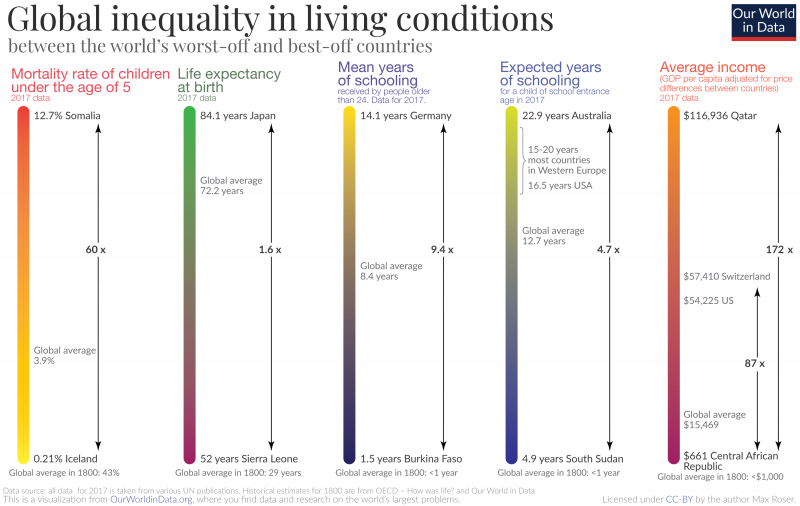
You cannot get healthy and wealthy on your own – Societies brand progress, non individuals
What is true for inequality across countries around the globe today, is also true for alter over fourth dimension. What gives people the chance for a good life is when the entire society and economy around them changes for the better. This is what development and economic growth are about: transforming a place and then that what was previously only attainable for the luckiest few comes into reach for almost.
When everyone is sick, anybody is sick
The blue line in this visualization shows this transformation of Finland, a state where people today are among the healthiest and richest in world history.
The datapoint in the top left corner describes life in Finland back in 1800 (a time when the country was not nevertheless autonomous or independent). Of all children built-in that year 42% died in the get-go five years of their lives. And the boilerplate income in Republic of finland was extremely low: Gross domestic product per capita was only $827 per year (this is adjusted for toll increases to continue the purchasing power comparable to today). And similarly, even basic education was not available for nigh.
A club where about half of all children died was not unusual: it was similarly high in humanity's history until but very recently. The dashed purple line in the chart shows that around the world in 1800 a similarly high share of children died earlier they had their 5th birthday. At that time there was little global inequality; life was brusk everywhere and no matter where a child was born, chances were high that he or she would die before long.
And just as at that place was picayune inequality in bloodshed and health between different places effectually the world, in that location was as well piddling inequality within countries. The health of the entire society was bad. We have data on the mortality of the English aristocracy from 1550 onwards. Aristocrats died just as early as everyone else.3 Their life expectancy was beneath 40 years besides. Before broader social development fifty-fifty the most privileged status within order would non give yous the take a chance for a salubrious life. You simply cannot be salubrious in an unhealthy place.
Evolution and global inequality
After ii centuries of slow, but persistent transformation, Finland is today 1 of the healthiest and wealthiest places in the world. Information technology wasn't polish progress – during the Finnish Famine in the 1860s the bloodshed rate increased to over half – but gradually kid health improved and today the kid mortality rate is 0.23%. Within two centuries, the chances of a Finnish kid surviving to the outset v years of its life increased from 58% to 99.77%.
The same is true for income. Back in 1800, global inequality between countries was much lower than it is today. Even in those countries that are today the richest in the earth the bulk of people lived in extreme poverty until recently. Republic of finland was no exception.
The scarlet bubbling in the same chart show kid mortality and incomes around the world today. It is the same data that we discussed to a higher place in the discussion on the extent of global inequality today, simply now y'all see the data for all the earth's countries, not but the worst- and best-off.
Until effectually 1800, today'due south best-off places were as poor as today's worst-off places, and child bloodshed was fifty-fifty worse. All were in the top-left corner of the chart. What created the global inequality we come across today were the big cross-country differences in improvements in health and economic growth over the last two centuries. Angus Deaton referred to this equally the 'Great Escape'. He wrote a book almost it with this championship in which he chronicles how some parts of the world escaped the worst poverty and affliction, while others lagged backside.
Without looking at the data it is non possible to sympathize just how dramatically the prosperity and health of a social club tin can be transformed. The health and prosperity in the past was so very bad that no 1 in Finland could have imagined living the life that is today the reality for the average person in Finland.
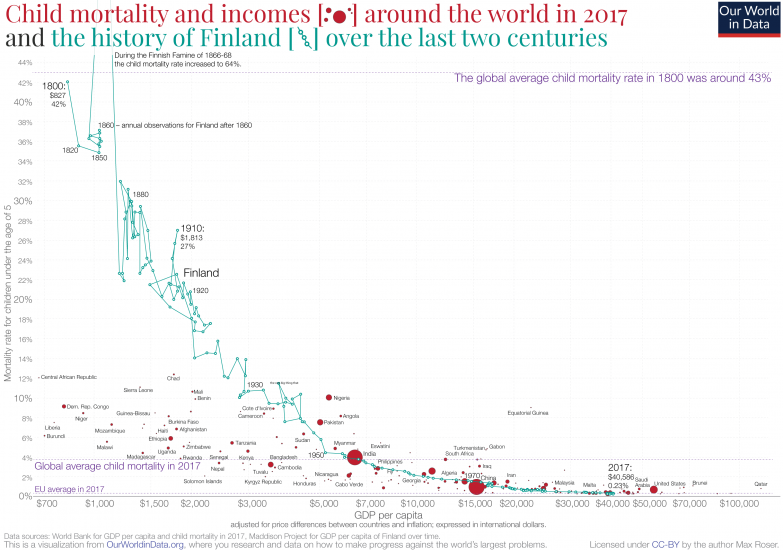
Development caused an inequality between places and between generations
Fifty-fifty the countries where health and access to instruction are worst today have made progress in these dimensions. In the outset chart of this text I added the estimates for the global boilerplate for each dimension two centuries agone underneath each scale. In terms of health, even today's worst off places are faring better than the best-off places in the past. Here is the bear witness for life expectancy and here for child bloodshed.
And simply as there is almost no overlap between the distributions of income in today'south poor and rich countries, at that place is also nigh no overlap betwixt the distribution of income in a rich country today and that of the same state in the past.
The fact that these transformations improved the living conditions of unabridged societies and so dramatically, means that it'southward not simply where you are born that matters for your living atmospheric condition, only also the time when you were born. Children with a proficient chance of survival are not only built-in in the right place, only also at the right time. In a world of improving health and economic growth, all of us born in the recent past have had much meliorate chances of adept wellness and prosperity than all who came before us.
Conclusion
As Atkinson said, "if we are concerned about equality of opportunity tomorrow, nosotros need to be concerned about inequality of outcome today."
The global inequality of opportunity in today'due south globe is the upshot of global inequality in health, wealth, teaching and the many other dimensions that matter for our lives.
Your living conditions are much more determined past what is outside your control – the place and time that you are born into – than by your own effort, dedication, and the choices you accept made in life.
The fact that it is the randomness of where a child is born that determines his or her chances of surviving, getting an instruction, or living free of poverty cannot exist accepted. We have to terminate this unfairness and so that children with the best living weather are just equally likely to exist born in Sub-Saharan Africa as in Europe or North America.
We know that this is possible. This is what the historical perspective makes clear. Today Finland is in the bottom correct corner of the chart above: i of the healthiest and richest places on the planet. Ii centuries ago Republic of finland was all the mode in the top left: equally poor a place as today's poorest countries and with a child mortality rate much worse than any place in the world today.
The inequality that we come across in the world today is the consequence of diff progress. Our generation has the opportunity – and responsibility I believe – to allow every part of the world to develop and transform into a place where wellness, access to education, and prosperity is a reality.
In that location is no reason to believe that what was possible for Finland – and all other countries in the bottom right which today are much healthier and wealthier than they were two centuries ago – should not be possible for the balance of the globe. Indeed, every bit shown by the massive reduction in global kid bloodshed betwixt 1800 and 2017 – from a global average of 43% to three.9%, every bit indicated by the horizontal dashed lines – much of the world is well on its fashion.
Both the progress of the by and the huge inequality effectually the world today evidence what is possible for the future. The William Gibson quote "the time to come is already here, it is just unevenly distributed" has been true for the entire course of improving living conditions and was a skilful guide for what is possible for the future everywhere.
We at Our World in Information focus on "data and research to make progress against the largest global bug" (this is our mission) and global inequality is 1 of them. Once we know what is possible we surely cannot accept today'south brutal reality that information technology is the place where a child is born that determines their chances for a wealthy and healthy life.
Global divergence followed past convergence
The chart shows estimates of the distribution of annual income among all globe citizens over the concluding ii centuries.
To brand incomes comparable across countries and time, daily incomes are measured in international-$ — a hypothetical currency that would buy a comparable amount of goods and services that a U.Southward. dollar would buy in the Usa in 2011 (for a more detailed explanation, run into here).
The distribution of incomes is shown at 3 points in time:
- In 1800, few countries had accomplished economic growth. The nautical chart shows that the majority of the world lived in poverty with an income similar to the poorest countries today. Our entry on global extreme poverty shows that at the get-go of the 19th century the huge majority—more fourscore%—of the world lived in material conditions that nosotros would refer to as extreme poverty today.
- In the yr 1975, 175 years later, the world had inverse—information technology had become very unequal. The world income distribution was 'bimodal', with the two-humped shape of a camel: one hump below the international poverty line and a 2nd hump at considerably higher incomes. The world had divided into a poor, developing world and a developed world that was more than 10-times richer.
- Over the following 4 decades the earth income distribution has once more changed dramatically. There has been a convergence in incomes: in many poorer countries, especially in Due south-Due east Asia, incomes have grown faster than they take in rich countries. Whilst enormous income differences remain, the world no longer neatly divides into the ii groups of 'adult' and 'developing' countries. We take moved from a two-hump to a ane-hump world. And at the aforementioned time, the distribution has as well shifted to the right—the incomes of many of the world's poorest citizens accept increased and extreme poverty has fallen faster than e'er before in man history.
We accept visualized a similar dataset from the OECD here.4
Global inequality in 1800, 1975, and 20155
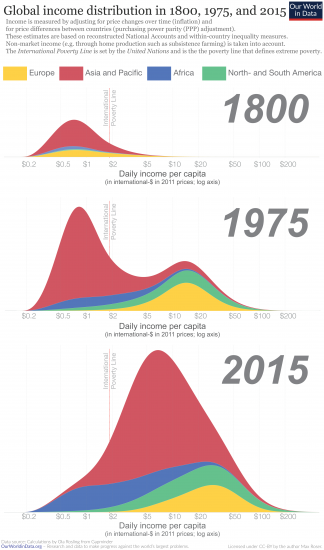
Global income inequality increased for 2 centuries and is now falling
This visualization shows the distribution of incomes between 1988 and 2011. The information was compiled past the economists Branko Milanovic and Christoph Lakner.6
To see the change over fourth dimension, select the years only above the distribution.
The previous visualization, which showed the the change from 1820 to the year 2000 is based on estimates of inflation-adjusted average incomes per country (GDP per capita) and a measure out of income inequality within a country only. It gives us a rough thought of how the distribution of incomes changed, but it is not very detailed and non very precise. In contrast to this, the work past Branko Milanovic and Christoph Lakner is based on much more detailed household survey information. This information measures household income at each decile of the income distribution and the two authors used this data to make it at the global income distribution. The downside of this approach is that we can merely go every bit far back in time equally household surveys were conducted.
The visualization shows the end of the long era in human history in which global inequality was increasing. Starting with industrialization in North-Western Europe, incomes in this role of the world started to increase while textile prosperity in the residuum of the globe remained low. While some countries followed the European industrialization – first Northern America, Oceania, and parts of South America and later Japan and East asia – other countries in Asia and Africa remained poor. As a consequence of this, global inequality increased over a long catamenia of time. Simply in the catamenia shown in this visualization did this change: With rapid growth in much of Asia in particular, the global distribution of incomes became less unequal. The incomes of the poorer half of the world population rose faster than the incomes of the richer half of the earth population.
If you lot want to use this visualisation for a presentation or for educational activity purposes etc. you tin download a nada folder with an image file for every yr and an animated .gif here.
Global Income Distribution 1988 to 2011seven
The latest data on global inequality and a await into the hereafter
This visualization shows how the global income distribution has changed over the decade up to 2013. Tomáš Hellebrandt and Paolo Mauro, the authors of the paper8 from which this data is taken, ostend the finding that global inequality has declined: the Gini coefficient of global inequality has declined from 68.seven to 64.9.
The visualisations above testify the income distribution on a logarithmic x-axis. This nautical chart in contrast plots incomes on a linear x-axis and thereby emphasizes how very high global inequality even so is: The bulk of the globe population lives on very low incomes and the income distribution stretches out very far to the college incomes at the right-paw side of the nautical chart; and incomes over 14,000 international-$ are cut off equally they would make this chart with a linear x-centrality unreadable.
A 2d striking and very positive global development shown in this chart is the ascension of the global median income. In 2003 one-half of the earth population lived on less than 1,090 international-$ per twelvemonth and the other one-half lived on more than 1,090 international-$. This level of global median income has virtually doubled over the last decade and was ii,010 international-$ in 2013.
Finally, the authors also dare to make a projection of what global inequality will wait like in 2035. Bold the growth rates shown in the insert in the top-right corner, the authors project global inequality to decline further and to reach a Gini of 61.3. At the same time the incomes of the globe's poorer half would go on to increment strongly then that the global median income could once again double and reach 4,000 international-$ in 2035.
If you are looking for a visualisation of just the observed global income distribution in 2003 and 2013 you find information technology hither.
The global income distribution in 2003, 2013, and the projection for 20359
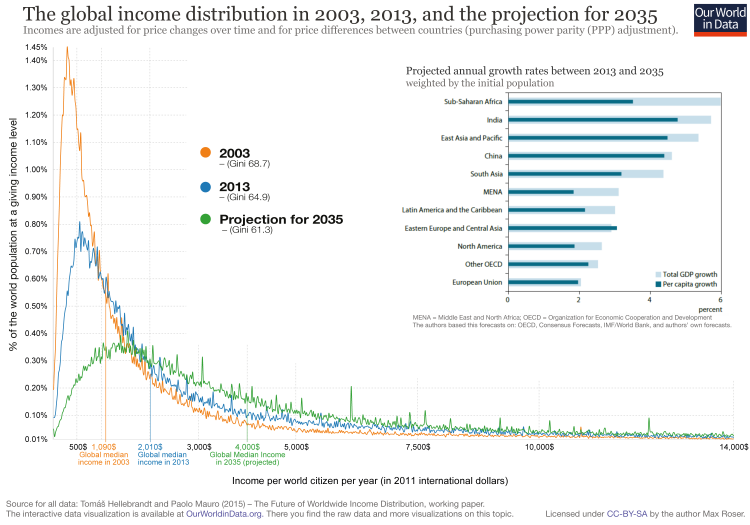
How global inequality has changed from 2003 to 2013
The following visualisation offers an alternative view on the information by Hellebrandt and Maurox shown in the chart before.
The chart shows the yearly disposable income for all world citizens in both 2003 and 2013. On the ten-axis you see the position of an private in the global distribution of incomes and on the logarithmic y-axis you see the annual dispensable income at that position.
The increment in prosperity—and decrease of poverty—is substantial. The income cut-off of the poorest ten% has increased from 260 international-$ to 480 international-% and the median income has almost doubled from 1,100 international-$ to two,010. Global mean income in 2013 is v,375 international-$.11
The global income distribution in 2003 and 201312
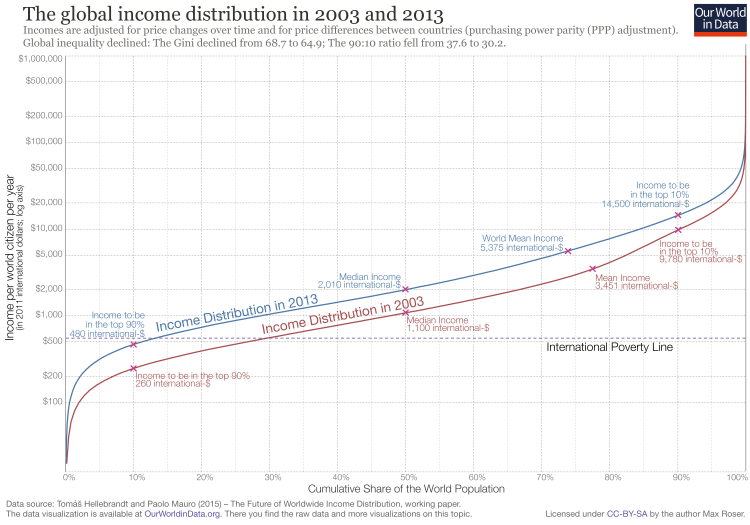
Global income inequality is very high and volition stay very loftier for a long time
The visualization presents the same data in the same way, except that the y-axis is now not logarithmic but linear. This perspective shows the still very high level of global inequality fifty-fifty more clearly.
The previous and the following visualisation show how very high global income inequality nevertheless is: The cut-off to the richest 10% of the world in 2013 was 14,500 int-$; the cut-off for the poorest 10% was 480 int-$. The ratio is thirty.2.
While global inequality is yet very loftier, we are at present living in a period of falling inequality: In 2003 this ratio was 37.vi. The Gini coefficient has likewise fallen from 68.vii to 64.9.
Taking the historical experience as a guide for what is possible in the future we have to conclude that global inequality volition remain high for a long fourth dimension. To understand this, we can ask how long it would take for those with incomes at the poorest 10% cutoff to achieve the current incomes of the richest 10% cutoff (which is 14,500 international-$). This income level is roughly the level of Gross domestic product per capita above which the poverty headcount gets shut to 0% for most countries (see here).
How long does it take for incomes to grow from 480 int-$ to 14,500 int-$?
The global income distribution in 2003 and 201313
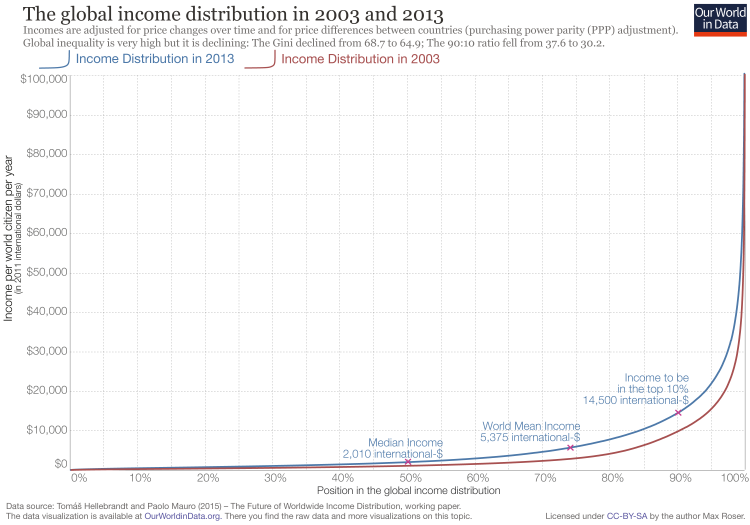
| 2% growth | 172.1 years |
| iv% growth | 86.9 years |
| vi% growth | 58.5 years |
| 8% growth | 44.3 years |
| ten% growth | 35.8 years |
Even under a very optimistic scenario it volition have several decades for the poor to attain the income level of the global top 10%.
2% is roughly the growth rate that the richest countries of today experienced over the concluding decades (encounter hither). We take seen that poorer countries can achieve faster growth, merely we have not seen growth rates of more than 6% over a time frame as long every bit necessary to attain the level of the global ten% in such a short time. If the past is a practiced guide for the hereafter, the world will very likely exist highly unequal for a long time.
Inequality within countries and inequality betwixt countries
Global inequality is driven by changes both of the inequality within countries and the inequality betwixt countries. This visualization shows how both of these changes determine the changing global inequality.
– Inequality within countries followed a U-shape pattern over the course of the 20th century.
– Inequality between countries increased over the course of 2 centuries and reached its peak level in the 1980s co-ordinate to the information from Bourguignon and Morrison shown hither. Since so, inequality between countries has declined.
As is shown in this visualization, the inequality of incomes between different countries is much higher than the inequality within countries. The consequence of this is that the trend of global inequality is very much driven by what is happening to the inequality between countries.
Global inequality between globe citizens and its components 1820-1992xiv
Full screen view Download Data
Data Quality & Definition
Irresolute relative and absolute inequality
Global inequality is extremely high and on many of the previous charts incomes are plotted on a logarithmic axis. Here you run into the change on a linear axis.
Growth convergence vs absolute income convergence, 1990-2003 – Todaro & Smith (2011)15

Data limitations
The already mentioned report by Sudhir Anand and Paul Segal is a very good review of this topic.xvi
Full and between inequality: comparisons of unlike studies – Liberati (2013)17
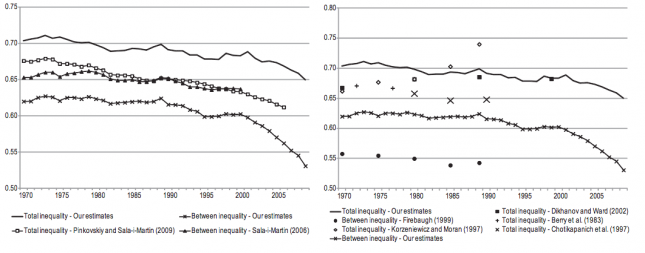
fairleyhicithove1960.blogspot.com
Source: https://ourworldindata.org/global-economic-inequality
0 Response to "What Money Canã¢â‚¬â„¢t Buy Family Income and Childrenã¢â‚¬â„¢s Life Chances"
Post a Comment